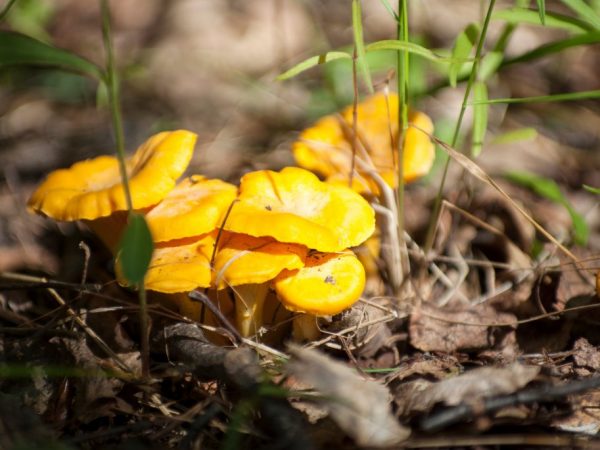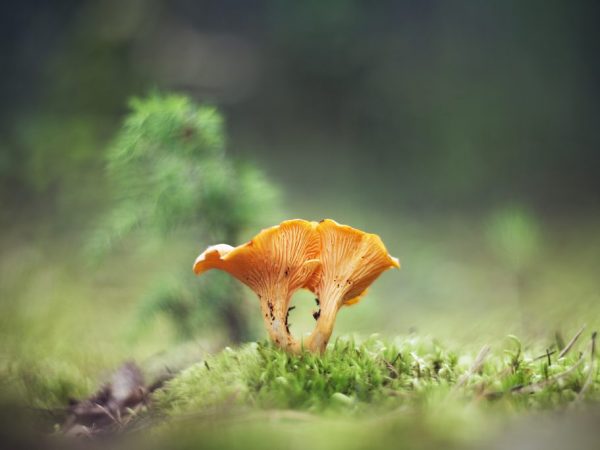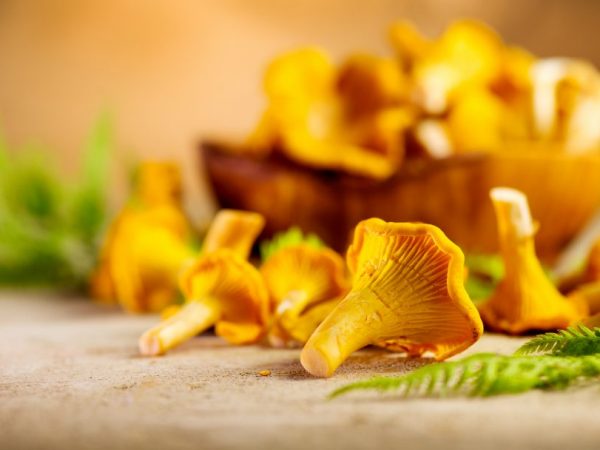Collection of chanterelle mushrooms
Chanterelle mushrooms, or Cantharellus, is a prominent representative of Basidiomycetes. They belong to the Chanterelle family. These mushrooms are edible species, but real chanterelles are often confused with their poisonous counterparts.

Picking mushrooms Chanterelles
general characteristics
Outwardly, chanterelles are somewhat similar to lily flowers.
The cap and leg of chanterelle mushrooms are about the same color, smoothly passing from light yellow to orange. The diameter of the cap is 5-12 cm. The cap is irregular, flat with wavy edges curled inward, or funnel-shaped. There is a recess in the central part.
The chanterelle is velvety to the touch, covered with a hard-to-peel skin. The pulp consists of fibers, dense structure, white or yellowish, when pressed, it acquires a reddish tint. Exudes a barely perceptible aroma of dry fruits. Sour taste.
The height of the leg is 4-7 cm, narrowed downward. The hymenophore is folded or, as they say, pseudo-lamellar. It consists of fibrous folds descending along the leg. In some species of chanterelles, the hymenophore is veiny.
Propagated by yellow spore powder. Fungal spores have a rounded shape, their size is 8x5 microns. The chanterelle appears in the forest in summer, in May-June, when the rains begin. They are easy to find after heavy rainfall at a temperature of 18-27 ℃. Forms mycelium on the roots of coniferous and deciduous trees, hides under mosses and grass.
They grow in numerous groups. Distributed throughout Russia and Ukraine. If the rainy season lasts a long time and there is a high humidity, choose areas that are illuminated by the sun. The main difference is that worms do not eat them. It is better to store them frozen or dry.
Views
According to the description, chanterelle mushrooms have more than 60 representatives. There are no poisonous among them. The only conditionally dangerous ones are false foxes, which are represented by the types of talker yellow and black. But for those who know how to cook it, it will be a delicacy. The poisonous twin is called the olive omphalot.
False representatives can grow in steppe zones and deciduous forests. The description of external data is similar to that for edible representatives. False chanterelles appear in early May.
Varieties: common chanterelle, l. cinnabar red, l. velvety, l. faceted, l. yellowing, l. tubular, l. gray.
Ordinary
This type is represented by edible, tasty yellow-orange mushrooms. The white common chanterelle is less common. The size of the cap is 2-12 cm, depending on age, climate. The fruit body of a real chanterelle is dense, fleshy, yellow, closer to the center and white at the edges. The taste is characterized by a slight sourness.
The skin is difficult to separate from the cap. The height of the leg is 4-7 cm. The chanterelle is not attacked by parasites, it grows on any soil. It includes chinomannose, which destroys all types of worms. The first representatives appear in June, then in August-October.They begin to collect them 2-3 days after heavy rainfall.
Cinnabar red
Edible species of red chanterelle mushrooms. The diametral plane of the cap reaches 4 cm, the height of the leg is 2-4 cm. It is colored maroon, almost black in shaded forests. The hymenophore is folded with pink thick false plates.
The pulp is massive, dense. Spore powder, creamy pink. Chanterelle harvesting season is May-October. Grows in oak groves, on well-moisturized soils. From a distance they look like blossoming flowers.
Velvety
A rare food representative of the family. They called it that for the velvety texture of the skin on the cap. The color of the cap is orange-yellow or red, the diametral plane is 5 cm. Its structure is spherical in the young specimen, and funnel-shaped in the old one. The leg, widened in the upper part, is several tones lighter than the cap, its height reaches 4 cm, and its diameter is 1 cm.
The flesh on the cut is light orange, on the cap, in the area of the leg - light yellow, almost white. Delivers a pleasant aroma.
Irina Selyutina (Biologist):
The margins of the chanterelle cap are velvety curly or strongly wavy. The hymenophore is represented by thick plates, or rather, folds that go to the leg. They are branched, connected to each other by thin veins. As they age, their color changes: in young specimens it corresponds to the color of the cap, and in mature specimens it is gray-yellow.
The mushroom is found only in the southeast of Europe. Fruiting from July to October. Occurs singly or in small groups.
The velvety representative of chanterelles can be found in deciduous forests, steppes, on soils with an acid reaction. It is difficult to find them, tk. small mushrooms hide in dry grass and fallen leaves.
Faceted
Another representative of the steppe. Orange-yellow beautiful faceted chanterelles form regular large caps measuring 10 cm, connected to the legs. The hymenophore is large, smooth.
Spore powder yellow-orange. The pulp is massive, fibrous structure. It has a pleasant taste and aroma. High energy value makes it a complete substitute for meat products. In addition to the steppe zone, faceted chanterelles grow in oak groves in summer and autumn.
Yellowing

The mushroom is worth looking for in coniferous forests
A small edible mushroom, in the diametrical plane of the cap reaches 6 cm. The cap is funnel-shaped, one-piece, makes up a single whole with the leg. The yellowing chanterelle has a dense surface, the scales are brown, sometimes yellow-orange.
Leg of the same shade. The pulp is beige, tasteless and odorless. The hymenophore is smooth, less often with folds, colored beige. Scattering next to the mushroom, a beige-orange spore powder forms new myceliums. Summer species worth looking for in coniferous forests.
Tubular
Another edible representative of the Chanterelle family. The cap is 2-6 cm in diameter, the leg height is 3-8 cm. The shape of the cap is funnel-shaped, with wavy edges. The surface is gray-yellow, covered with scales of a velvety structure.
The pulp is dense, white. Has a bitter taste, emitting an earthy aroma. The lower part of the cap is composed of thin rare bluish-gray veins. Large representatives grow in coniferous plantings on moist soils, stand in even rows, which from a distance look like a flower meadow.
Gray
Mushroom gray or brown-black in color. The cap is funnel-shaped, up to 6 cm in diameter. The height of the leg is 3-8 cm. The flesh is dense, gray or brown. Before using it, it must be boiled.
The folded hymenophore tends to the pedicle. There is no aroma. The taste is inexpressive. Representatives of the variety, similar to the rowers, prefer mixed forests, belong to the category of autumn mushrooms and appear in August-September. They grow in flat, damp areas, closer to birches and oaks.
Beneficial features
Chanterelle mushrooms grow in the forest, but they are never wormy. This is their main feature. This fact is due to the presence of chitinmannose in the composition, which kills insect larvae and worms (helminths). The substance is a polysaccharide compound that can dissolve helminth eggs and paralyze adults. The effect of the substance is selective, therefore, it is not scary for a person.
100 g of pulp contains the daily norm of vitamin D. The trace element is involved in the development of bones, promotes better absorption of calcium. The product is enriched with vitamin B6, which promotes the elimination of toxins from the body, is involved in the construction of nerve cells in the brain. The pulp is rich in antioxidants that increase immunity and improve the condition of the skin.
The chemical composition of chanterelles is rich and varied:
- acids: folic, pantothenic, niacin (nicotinic) and acetylenic fatty acids;
- trace elements: chromium, copper, manganese, zinc, etc.;
- vitamins: beta-carotene, riboflavin (B2), D, C, A;
- ergosterol (vitamin D precursor), etc.
The nutritional value of mushrooms is 18.8 kcal per 100 g of product. Their sufficient protein content makes them an indispensable companion for people looking after their diet. They are a complete replacement for animal protein, which is a good opportunity to make up for its deficiency for those who count calories in their diet.
Contraindications

Chanterelles are contraindicated in pregnant women.
Taking drugs from chanterelles and eating them is contraindicated:
- pregnant and lactating women;
- children under 8 years of age; people with individual intolerance to mushrooms;
- people with mold allergies and diabetes;
- people with problems with the gastrointestinal tract and pancreas.
Mushrooms are heavy food. If you have problems with the pancreas, it is better to stop using them. For young mothers and young children, eating chanterelles can cause an allergic reaction or liver failure.
Attention! Poisoning can be triggered by mushrooms collected near landfills and road connections. Mushrooms accumulate toxins especially quickly in hot weather. Partially dried out overgrown specimens are also dangerous.
Application
Fresh young chanterelles are a natural antibiotic and pain reliever. With angina, they effectively relieve the swelling of the larynx and eliminate purulent layers. They help to increase the body's resistance to infection. The medicinal properties of a natural antiseptic are used in gynecology.
With the help of masks from the fruiting bodies of chanterelles, the condition of the skin is significantly improved. The tool helps to even out the complexion, eliminate puffiness, smooth out wrinkles. The active substances contained in the composition of the product renew skin cells, promote healing of wound surfaces and prevent the appearance and development of inflammation. Diets alternating meat and mushroom days are also effective. In traditional medicine, an extract from this mushroom is used. Balms, powdered antibiotics for local use are made from it.
Interesting Chanterelle Facts:
- in Nigeria, they are used as raw materials for the manufacture of creams and ointments for acne;
- in Normandy, the properties of the product were used to increase sexual desire: mushroom dishes were certainly served at weddings;
- in the 17th century. in France, the products belonged to delicacies: only aristocrats could eat mushrooms;
- thanks to the balanced BJU complex, chanterelle extract is used in the production of anti-aging creams;
- how long the mushroom can be stored depends on humidity; when this indicator rises to 80%, the product cannot be stored;
- from boiled mushrooms make lotions for eczema.
In cooking
For maximum benefit, please adhere to collection, storage and handling guidelines:
- the best time to collect is 2-3 days after heavy rainfall;
- dry the product in the sun;
- when mold appears, all stocks are disposed of.
To eliminate the bitterness, before cooking, the mushrooms need to be soaked for 15 minutes. After boiling water, the product is boiled for 10 minutes. Then they are used as raw materials for making soup, a second course with a garnish of hard noodles, rice or buckwheat. Fresh, soaked specimens are used to make salad. This dish will not only enrich the body with nutrients, but also help cleanse it of parasites (worms).
From dry chanterelles, you can cook soup or make an interesting sauce. Products can be stored in the freezer for no more than 12 months. When frozen, some of the nutrients are lost and the aroma leaves. The mushrooms are pre-blanched, dried well on a paper towel and put in sealed bags of 200-300 g (one-time portion). If the surface of the food is black, it can no longer be stored.
Dried products are soaked in milk for 50-60 minutes before cooking. Then they are used to make sauces, marinades. Mushrooms are suitable for making pickles. Basiomycetes grown during the heavy rains cannot be stored for a long time, so it is better to eat them right away.
In medicine

Mushroom will help with obesity
The useful composition of chanterelles has found wide application in folk and traditional medicine. Used when:
- uterine myoma;
- treatment of oncology as a pain reliever;
- colds;
- obesity;
- hepatitis.
Irina Selyutina (Biologist):
The beneficial properties of chanterelles are largely due to the presence of three important compounds:
- Chitinmannose: in addition to the destructive effect on helminths, it is used in the treatment of boils, abscesses and tonsillitis, and also inhibits the growth of tubercle bacilli.
- Ergosterol: cleanses the liver, has a positive effect on its enzymes.
- Trametonolinic acid: able to fight the hepatitis virus. In this regard, in Europe, chanterelles are used to treat hepatitis C and liver diseases.
The vitamins of group B, A, PP and trace elements copper and zinc contained in chanterelles make it possible to use them in ophthalmology. Thanks to this composition, you can save a person from "night blindness", restore the mucous membrane of the eyes, and improve vision.
Before use, the mushrooms need appropriate processing. For powder preparations, mushrooms are harvested raw: they are washed, dried on a towel and laid out to dry in the sun. Fully prepared foods, dry on the inside, are then ground to a powder in a coffee grinder or spice grinder.
To increase immunity and prevent hepatitis, take 1 tsp. a day in the morning, before meals (30 minutes), drinking plenty of water. On the basis of the chanterelle extract, they create drugs for cancer. So that the powdered medicines do not taste bitter, the products are first soaked in fresh milk for 10 minutes.
In veterinary medicine, it is used as a medicine for worms. Dried raw materials are added to the feed at 20 g per 1 kg of live weight. The worms leave the body of the animal after 3-7 days.
Growing
They began to grow chanterelles and mushrooms on personal plots in France. The personal gardeners of noble persons were engaged in this. Today, their breeding is practiced by the owners of large expensive restaurants, where food processing is immediately carried out.
Chanterelle mushrooms can be grown independently in the country or in the garden. This will require "infecting" the soil with spores. Spore powder is bought in specialized stores (can be ordered on the Internet) or mined independently. Ripe mushroom caps are soaked in sweetened water for 10 hours. Sugar is added at the rate of 100 g per 10 liters of liquid.
The fungus will develop near a tree similar to the one under which the mushrooms were collected. Chanterelle and camelina quickly adapt to the soil next to birch, oak, alder. Collect the top layer of soil around the trunk circle, spill the soil with a decoction of oak bark and pour out the spore water and spread the grated mushrooms. Cover with a layer of soil removed earlier. Monitor soil moisture.
It is better to plant mushrooms in the most moisture-consuming places of the site. Basiomycetes bear fruit well at a temperature of 20 ℃ and a humidity of 60-70%. This allows them to be planted in separate containers in greenhouses. Myceliums planted in a mixture of turf, sand, peat and rotten oak bark grow well.
The first "domesticated" basiomycetes will go in a year. Collect them carefully, leaving the mycelium in the soil. This will allow you to get a full harvest annually. The advantage of home cultivation is that false twins will not grow on the personal plot in this case.
Conclusion
Chanterelle mushroom is delicious. It grows rapidly on acidified soils, in forest and steppe zones. It is actively used in cooking, medicine and cosmetology. The reduced calorie content allows products to be added to the diet of obese patients. Similar to edible specimens, doubles are conventionally dangerous, rarely causing serious poisoning. But you should still approach the collection of these mushrooms with caution and attention.


